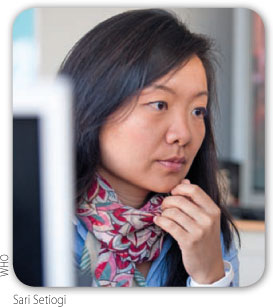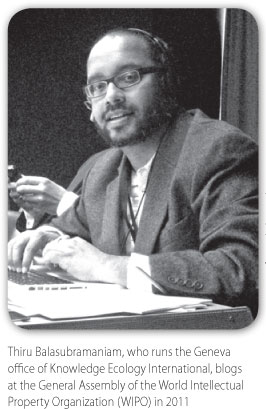NEWS
Mixed uptake of social media among public health specialists
Public health organizations are starting to use social media. Some specialists say they hold untapped potential for public health. Ben Jones reports.
Sari Setiogi was worried. In the wake of the Japanese earthquake back in March 2011, panic about the effects of a possible radiation leak at the Fukushima nuclear plant had caused a number of rumours to spring up on social networking site Twitter.
Chief among them was the misconception that drinking iodized wound cleaner and consuming large quantities of iodized table salt would reduce the effects of radiation (rather than potassium iodine tablets taken before exposure, which is recommended). Setiogi learned that people had started stockpiling salt in China. One person had built up a five-year supply. It was time for her to act.
Setiogi, a communications officer at the World Health Organization (WHO) in Geneva, knew she had to combat the wildfire spread of such rumours with some well chosen advice. At the same time, WHO's China Country Office and other public health agencies in China worked hard to raise awareness inside the country itself.
The joint efforts paid off. "[For our part] we tweeted asking people not to eat excessive amounts of table salt because it leads to hypertension, and within a couple of days we'd heard people had run back to the shops and asked for refunds for the salt!" Setiogi says. "People retweeted our message and the number of messages telling people to buy the salt went down."
Social media - networking web sites such as Facebook, Twitter, QQ in China, blogs, e-mail fora and video-sharing web sites - have only been around a few years. WHO is among the public health organizations using social media to disseminate health information and counter rumours. But should public health be making more use of such media?

Using social media may seem easy but users say it is time-consuming and can backfire when health messages become distorted, such as when they are retweeted. That can jeopardize organizational reputations and undermine the credibility of their information.
"Due to the nature of social media and the interaction on social media platforms, we can be sure of what we say but we just can't be sure how it will be changed by others", says Yousef Elbes, a multilingual manager responsible for disseminating health information via the Organization's multilingual web site. "When it comes to public health, information must be accurate, timely and reliable."
Elbes says that it is possible to protect sound public health information and advice via social media. "You have to provide the correct information but then you must have mechanisms in place to follow up and respond, reply and retweet if the messages are getting distorted."
WHO has a Facebook page, a Twitter feed and a section in YouTube, as do the Centers for Disease Control and Prevention (CDC) in the United States of America, several health ministries, universities that offer public health courses, and many scientists and health writers. There are popular blogs on health matters, such as Covering Health, run by the Association of Health Care Journalists for journalists. Another blog, the Pump Handle, describes itself as "a water cooler for the public health crowd", while the Wall Street Journal's health blog has a business focus.
CDC has uploaded 243 videos to video-sharing site YouTube, and Shelly Diaz, a social media expert at the CDC, says social media are a key means of getting the agency's message across to online visitors. For example, one CDC Facebook page is targeted at parents of teen drivers. "We spend a lot of time and we have a whole team of people working on social media. It's not investment free", she says. "We need a message that can be nimble. Social media allow us to upload messages quickly."
Not all public health organizations have embraced social media as enthusiastically as the CDC. Rajiv Rimal, associate professor in the Department of Health, Behavior and Society at Johns Hopkins University, contends that social media hold untapped potential for public health. He notes, though, that some public health organizations have found innovative ways to use these media. "Locating the presence of flu geographically based on people's search terms" during the H1N1 influenza pandemic in 2009, he says, was "a really cutting edge use".
This year Google, the Internet search engine, launched a similar web-based tool called Google Dengue Trends to monitor for dengue fever. The CDC also provide "widgets", which are small pieces of html code that users can upload to their own web sites. That way they can receive the latest CDC statistical updates, which is particularly useful during an outbreak.
The two-way nature that sets social media apart from traditional media also presents opportunities. Public health organizations can monitor these media to find out people's health concerns and interests, as well as to find out "what has been pushed out to them", Rimal says. He believes that social networks can be used to change people's behaviour, for example, in selecting the right sunscreen for children based on both evidence-based recommendations and on "what other mums are using".
While getting evidence-based health information and messages out to the public via social media may seem simple, the challenge is in listening and responding to questions and rumours in a timely way.
"Using social media [at WHO] came about because of lessons learned from the H1N1 [2009] pandemic response", Setiogi says. "There were a lot of rumours circulating but we didn't listen. We didn't know what people were talking about and what information they wanted from WHO. After that, we started changing our approach to social media." Two years on, in October of this year, WHO had about 255 000 followers on its Twitter feed and 30 000 'fans' on its Facebook page, numbers that increase every month.
For activists, social media can be an inexpensive and quick platform for their campaigns. Jamie Love, director of NGO Knowledge Ecology International, reaches wider audiences than ever before using his Twitter feed, where he has more than 2000 'followers', to publicize his web page. But he understands why some health professionals are wary of using social media.
"Some professionals may think that Twitter is just for extroverts who share what they just had for breakfast. But today Twitter is an important tool to share information and frame policy debates", Love says. "In a meeting or conference, tweets can reach the people in the front of the room, the back of the room and people who are not even in the room. You can comment on events in real time, even if you are not physically attending. It changes our sense of whose voices are being heard."
For Rimal social media are still underused, especially in linking large groups of people with common interests. "Social media help people who are concerned about similar issues to come together, to work together, to have a unified voice. That is an area that public health has not really adapted to yet, in terms of mobilizing social networks to promote a particular cause."
In countries with low internet bandwidth, e-mail is easier to use for virtual networking than social-networking web sites. One e-mail discussion forum, HIFA2015, aims to promote 'health information for all' with a focus on the developing world. "Social media can bring large numbers of people together to discuss, explore, learn around a focus of common purpose", says HIFA2015 coordinator Neil Pakenham-Walsh.
Rimal stresses the importance of "source credibility". "Where the information is originating from - whether it comes from one's friends, companies trying to sell a product or public health agencies - becomes that much more critical", he says. Not every user will check sources and many will be confused by the multitude of conflicting information. For example, there are more than 900 videos on YouTube expressing a wide range of views on vaccination and many blogs and web sites suggesting the links between smoking and lung cancer are myths.


Social media and the web give people a forum to express their views, but these are debates that may never reach a conclusion. For public health specialists this can be difficult ground. "Once you start interacting with social media, you have to be ready to carry the work forward", says Elbes of WHO. "You can't just start and stop."
A recent editorial in the British Medical Journal called widely-available health information "fundamental to global health improvement". Measuring the success of public health campaigns is often hard enough. But measuring the impact of social media beyond counting the number of retweets or using web-based tool Klout, which measures online influence, would require more time and a new method.
Diaz says the CDC recently surveyed its Twitter followers, asking if they were likely to make changes to their health behaviour based on the information they received via the CDC twitter accounts. "Most said that was likely", Diaz says.
"Theoretically, you can establish evaluation metrics for virtually anything", says Elbes of WHO. "But when it comes to public health, it's extremely difficult to measure the impact, because it takes years to see the impact on health."
